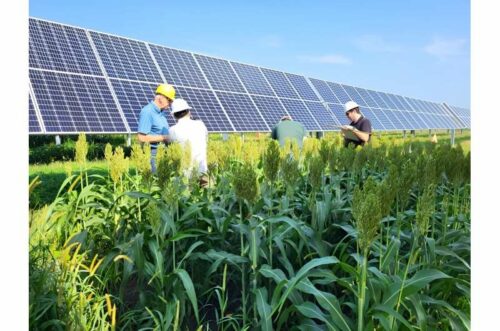Discover how agrivoltaics can make land more productive, improve water efficiency, combat heat stress, enhance carbon sequestration, and promote biodiversity while also exploring the challenges and unanswered questions surrounding its implementation.

Researchers from Texas A&M AgriLife are actively engaged in the expanding field of agrivoltaics. This technology holds promise for improving the efficiency and resilience of sustainable food and agricultural systems, all while meeting the increasing energy needs of the state. Despite Texas’ prominence in energy production, driven by its abundant reserves of fossil fuels and renewable resources, its rapidly growing population exerts continuous pressure on the electrical grid. The current year, the Electric Reliability Council of Texas recorded an unofficial record-breaking demand of 85,435 megawatts during a scorching summer heatwave.
Photovoltaic systems, commonly known as solar power arrays, play a vital role in meeting rising energy demands but often compete for land with agriculture. Agrivoltaics combines crop and livestock farming with solar arrays to optimise land use. Dr. Nuria Gomez-Casanovas, an assistant professor in regenerative system ecology at Texas A&M, emphasises the challenge of land scarcity as Texas’ population grows. She sees agrivoltaics, combining solar arrays and agriculture, as a solution to simultaneously meet energy and food needs. This dual-use approach allows for renewable energy and farming on the same land.
Enhancing Land Productivity
Agrivoltaics aims to boost profitability per acre for landowners and farms by generating income from food and energy. Using the land equivalency ratio, researchers found that growing crops beneath solar panels can increase land productivity by up to 60% compared to monoculture or standalone solar arrays. Additionally, vegetation under the panels can counteract biodiversity loss and the photovoltaic heat island effect caused by removing natural land cover and heat-absorbing materials.
Improving Water Efficiency and Mitigating Heat in Agriculture
Agrivoltaics can enhance solar energy generation and farming in Texas’ semi-arid regions. Solar panel shading reduces soil water evaporation, benefiting plant health during hot and dry periods. This saves water during irrigation, which is vital due to increasing scarcity. Though shading might seem to lower productivity, it often boosts crop yields, as seen in a 2019 study on tomatoes and chiltepin peppers. Plant-specific light requirements and panel arrangements need more research. Agrivoltaics may also benefit livestock by reducing heat stress through panel shade, potentially improving their well-being and productivity.
Accumulating Carbon and Enhancing Biodiversity
Optimised agrivoltaics can increase carbon sequestration in above- and below-ground plant biomass. However, prior land use plays a crucial role; native rangeland to agrivoltaic systems may hinder carbon sequestration while transitioning from low soil organic carbon agriculture to agrivoltaics can be beneficial. Plant selection, soil types, and agricultural practices impact carbon storage in agrivoltaics. Managing vegetation beneath arrays, like restoring native plants or planting pollinator-friendly species, can promote biodiversity.
Challenges in Implementation
While agrivoltaics promise higher crop yields and additional energy, they involve significant upfront costs and long-term uncertainties. Economic viability is crucial for farmers considering adoption, leading to numerous unresolved questions. These include energy storage infrastructure, pricing, crop choice, solar panel setup, and policy support like tax credits. Gomez-Casanovas sees these unanswered questions as a guide for future interdisciplinary research.






